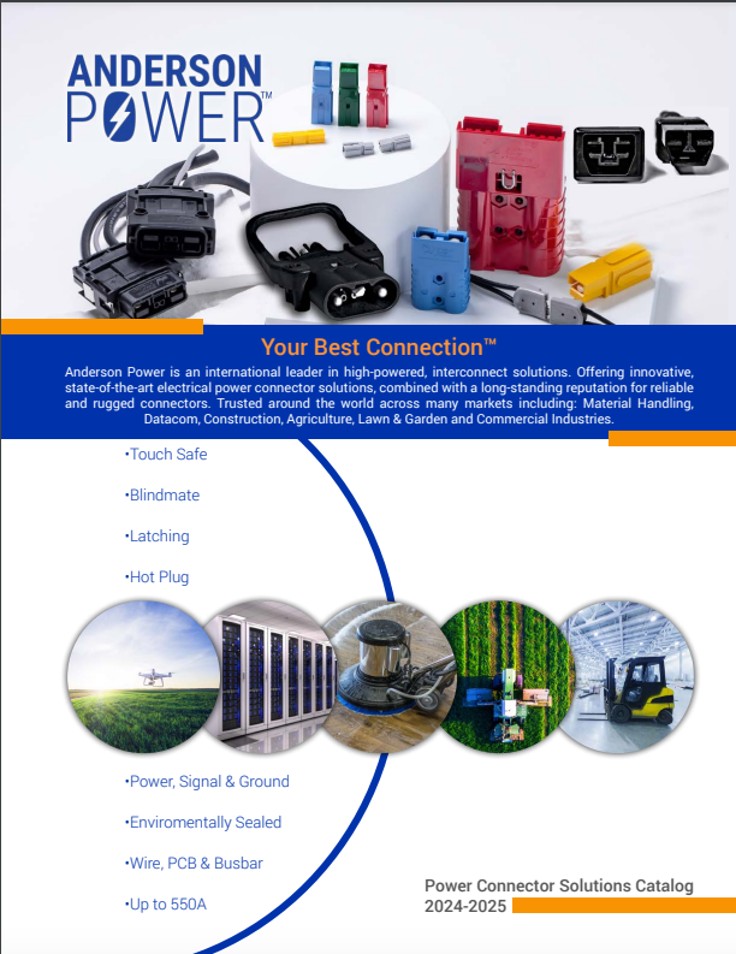- I need a 3D drawing.
To locate a 3D drawing, please select the learn more button from the connector product you wish to inquire about at the address below, and then select 3D files button. Please note we do not provide 3D drawings of contacts. https://www.andersonpower.com/us/en/ProductPages.html
Please note that you must be registered on the website and logged in to download a 3D file. If there is not a 3D file on the website please contact tech support for assistance ustechsupport@andersonpower.com
- What Is the difference between a dust vs boot cover?
Dust covers prevent dirt and dust from entering the mating interface when not connected. Boots provide water, dirt, chemical and UV protection for the connectors in both mated and unmated conditions and are rated for Ingress Protection.
- May I mate same housing colors but have different size contacts in the housings?
Yes. You may mate the housings together if they have different wire/contact sizes. However, the amperage will derate down to the lowest wire gauge.
- What are fingerproof housings? Can I mate them with non fingerproof housings?
Fingerproof housings add a level of safety to our products. There are ribs on the mating interface that protect against accidental exposure to live contacts and meet UL standards. Fingerproof housings should never be mated with non fingerproof housings. Forcing these together will cause damage to the housings.
- What is the function of reducer bushings with the contacts?
Bushings reduce the inner diameter of the contacts to accept a smaller wire gage. If the wire is too small for the contact be used we may offer a reducer bushing. Reducer Bushings are available to be used with specific contacts. Bushing part numbers can be found on the datasheet for each product. Please note that usage of a bushing with a contact has not been agency tested for approval.
- How many volts are your connectors rated for?
Most of Anderson Power Products are rated for 600 volts per UL 1997. Please see specific datasheet for specific ratings.
- Why are the SB/SBS/SBE/SBX Connectors color coded and keyed?
Anderson power has developed different mechanical keys that coincide with the National Electric code voltage level to prevent incompatible voltages from being cross mated. Note however the mechanical keying and color does not restrict the voltage capability of the connector. Most of Anderson Power Connectors are rated to 600 volts per UL 1977 (see datasheet for specific ratings).
- I need to qualify that the connectors I have are true APP connectors
The only way to guarantee true Anderson Power Products is to purchase from one of our authorized distributors or from our webstore.
- May I mate connectors together that have low and high mating force contacts?
Yes. However, APP has not tested this for safety regulation approval, and it should be noted that the contacts will wear at an accelerated rate causing the mating cycles to be reduced. Since the user is mating low and high force contacts the mating force would be somewhere in between what is listed for the high and low mating specification.
- Should I mate housings together without contacts?
Anderson Power connector housings are designed to be mated when crimped/soldered contacts are installed within the housing. Please do not attempt to mate the housings unless the contacts are installed. If you attempt to mate the housings without crimped contacts installed, you could damage the housing or spring.
- Can I mate Anderson housings with a non-Anderson housing?
Only Anderson Power product housings should be mated with each other. Mating Non-Anderson parts with Anderson Power products will void UL certifications, warranties, and liability if an incident should occur.
- I have connectors that are melting. What might be the cause?
Connectors can show signs of melting caused by improper crimping, having damaged/broken wires caused using unapproved tooling, signs of corrosion or in some cases using a connector/wire size not properly sized for your application.
- Where do I locate information on the crimp tool that is qualified with the housing and contact being used?
Information can be found by going to the datasheet for the product you are using. To find these select the product pages tab at the top of the website and scroll to last page to find the tooling chart. There it will show details on what tools are approved for each of the contacts and housings.
- What rules should I follow for crimping if I am not using Anderson’s recommended tooling?
If you choose not to use approved and tested Anderson Power Products tooling, then it is recommended that you refer and following the crimp specification guidelines for the product you are using. Crimp specifications can be found under the technical area on the product pages for each product category.
- Can I solder contacts instead of crimp?
Yes, soldering can be used as an alternative to crimping. Directions are listed on the assembly document for each connector
- Where do I locate datasheets, drawings, assembly documentation, tooling and crimp specs for each Product line?
Please reference the learn more tab on the Product Pages found at the following location https://www.andersonpower.com/us/en/ProductPages.html
- Where do I locate ROHS and REACH documentation and other certifications?
Please reference the Resources tab on the website found at the following location. Most certifications can be located there. https://www.andersonpower.com/us/en/resources.html
- Do you have Videos of your connectors?
Videos can be found at the following link for Anderson Product Connectors https://www.youtube.com/user/AndersonPowerP







